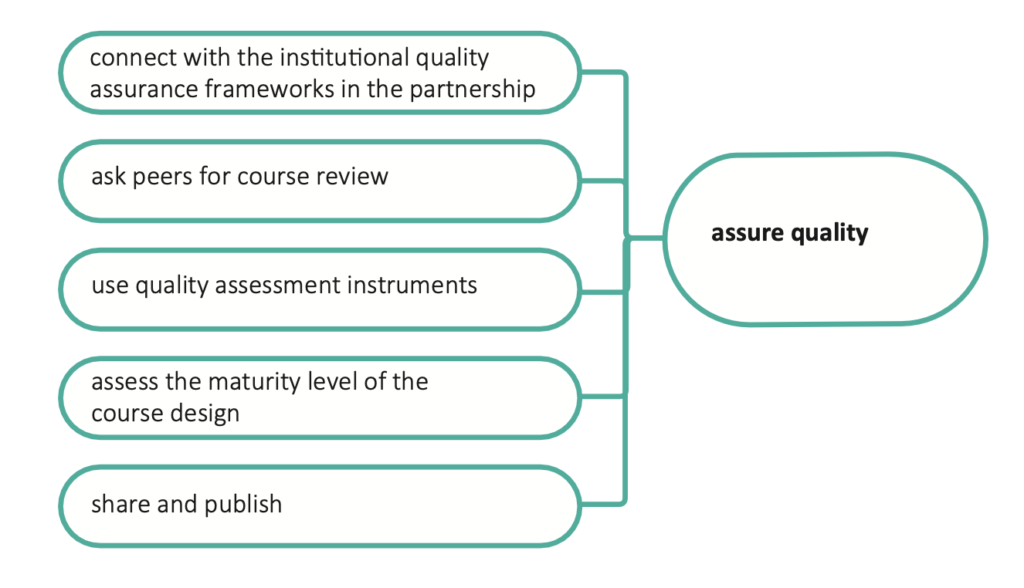
| The quality assurance for a joint micro-credential course is a common responsibility of the course team. In this respect decisions have to be taken as: |
| Connect with institutional quality assurance frameworks in the partnership; |
| Ask peers for course review; |
| Use quality assurance instruments; |
| Assess the maturity level of the course design; |
| Share and publish |
Guidelines
Connect with institutional quality assurance frameworks in the partnership
The course team draws up a quality assurance plan for the joint course, building on the internal quality assurance approaches of the respective universities. Possibly, partner universities have installed a quality assurance approach for joint courses.
The course team is jointly responsible for the scientific content and the EQF level of the course.
Quality assurance takes into account a variety of criteria and indicators, in particular:
- learning progress and success throughout the course;
- compliance of the learning results with the pre-specified learning outcomes and competences;
- the learning experience and satisfaction during the course;
- the content and level of the course;
- data from learning analytics
The institutional quality assurance procedures will comply with ENQA Standards and Guidelines for Quality Assurance in Higher Education. For the aspects of online learning, it follows the Considerations of the ENQA Working Group on Quality Assurance and E-learning.
Ask peers for course review
Typical for asynchronous online learning units is that they can be evaluated by peers before they are implemented in real life. In many universities, this evaluation is a standard procedure in the development phase of the course, even when members of the course team have continuously discussed each others’ learning units beforehand.
Use quality assurance instruments
E-xcellence is a quality assurance instrument for blended and online education. The self-assessment tool is accompanied by and extensive manual offering guidance for improvement, covering blended and online course and curriculum design, student and staff support and strategic management.
Both the manual and the tool can be relevant when teaching staff is designing and developing a course, also before implementation. See: https://e-xcellencelabel.eadtu.eu/e-xcellence-review/manual
E-xcellence offers also onsite reviews for ex post quality assurance
Assess the maturity level of the course
The European Maturity Model for Blended Education (EMBED) can be used to assess the maturity level of courses, programmes and institution-wide provisions for blended education. The concept of maturity refers to the degree of regular deliberate optimization of the design of blended education and evidence-based decision-making by the course team and individual teaching staff. See: https://embed.eadtu.eu/download/2517/EMBED%20implementation%20guidelines.pdf?inline=1
Share and publish
As education is a design science, it is good practice that teaching staff and course teams publish about the design, the development and implementation of courses as is done in other design sciences (architecture, engineering, etc.). By sharing and publishing, teaching staff will level up their own ambitions and create a culture for developing quality courses in the higher education community (Laurillard, 2021).
Also, course material can be published in open educational resource databases or courses can be made available for learners to learn in their own pace.
next chapter: Develop a business plan
previous chapter: Determine formative and summative assessment approaches
back to overview: Models and guidelines for the design and development of
joint micro-credential courses and microlearning units in higher education
